Dance of the Seven Veils

Script and preliminary instructions for staging
by David Thomas, PhD
[Dancers who are to hold “sculpted images” are in place at the back of stage. Narrator is with them. Salome also with them. Narrator walks from the back of the stage into the light.]
“Good evening, ladies and gentlemen, and welcome.”
“Tonight, we offer you a performance for the pleasure of your imagination. We hope to entertain you. We want that most of all. But we also hope to move you to feeling and to thought. With this evening’s performance we invite you to look past the masks of everyday life, there to glimpse the animating spirit we have in common.”
“‘With the eye you look at the world,’ said the Romantic Poets, ‘with the imagination you look into it,’ Only with the imagination can you see beyond the veils that divide us. That was their view and tonight, we invite you to test for yourself the worth of that view.”
“For our purposes, the effort to see the world with the imagination begins and ends with dance. And what dance more fully invites the use of the imagination than does the Dance of the Seven Veils?”
[Light comes on Salome who begins the dance of the seven veils.]

“For centuries, poets, painters and dancers have tried to unravel its deeper meaning. Rubens painted it, as did Moreau. Flaubert and Oscar Wilde wrote plays about it. The American writer, Tom Robbins, wrote about it, as well, and now, we, too, will examine it, offering our own interpretation.
[Light goes out on Salome who exits stage.]
“Here, for the purposes of our performance, is our view: Whatever we are and whatever our source, we are delighted to awaken here, for here there is space and time enough for us. Here there is a stage whereon we may express ourselves, evolve ourselves, perhaps adding and experiencing beauty and wonder in the process. But to come here we must mask ourselves with form.”
[Dancers representing the various veils are illuminated as they assume and hold their sculpted poses.]
“We must mask ourselves with the veils of gender, race, class, culture, age, belief, and behavior, the Seven Veils.”
“Once veiled, however, in the midst of this extraordinary whirl of color, shape, and movement, we become confused, perhaps forgetful. So profoundly confused and forgetful that we often conclude of others–and of ourselves, as well–that they are nothing more than the veils that mask them. We say of this fellow or that fellow: ‘He is nothing but an old white man with foolish beliefs. Dismiss him! When, in fact, we merely are announcing the degree to which we are unable to look past the veils to what is hidden.”
“The danger of this confusion, this forgetfulness is that it allows us to fall prey to the “isms” that accompany each veil; to the sexism, racism, classism, ethnocentrism, ageism, fanaticism, behaviorism that are the result of the surface view; indeed, to all the “isms” that would have us respond to others as though they are categories and not unique expressions of the humanity we share.”
[Lights out on sculpted images. Dancers stay in place as “Veils” performers take their place in wings.]
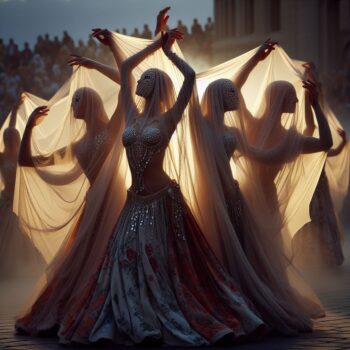
“So, for us, the message of the Dance of the Seven Veils: Overcome the confusion, the forgetfulness, cultivate the imagination, and with it look past the veils, there to glimpse, if only for a moment, the animating spirit at the center of our play.”
[Narrator exits stage. Lights up as dancers perform “Veils.”]
– APPLAUSE –
[“Gender” dancers take their place. Narrator walks into light.]
“The first of the Seven Veils is the veil of gender, the most fundamental of veils. Male and female. The whole divided in two. Through the interplay of male and female comes the coil of life, shaped, nurtured, and furthered on its way… and yet, always, there remains the drama of the individual male and female, the part longing to be whole, in service to a force larger than itself.”
[Narrator exits stage. Light comes on dancers as they perform “gender” dance.]
– APPLAUSE –
[Dancers for “race” dance take their places. Narrator walks into light.]
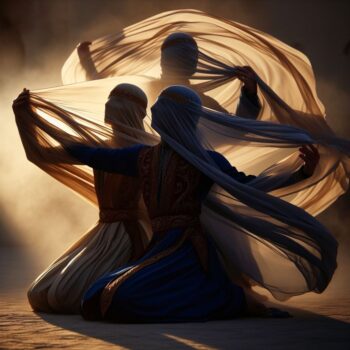
“The second veil is the veil of race. ‘There is only one race,’ said the great Buckminster Fuller. ‘Only one race.’ He must have been mad! And yet, he insisted, so overcome with confusion are we that we allow a difference in color to imply a difference in kind. Instead of identifying with the whole, we identify with the part.”
“History, said Norman Mailer, has seen fit to pit the basics against one another: Male against female, Black against white, in one last overly assertive effort to reach us, testing our capacity for reconciling differences and for overcoming what some have said is our gravest problem, the problem of mistaken identity.”
[Narrator exits stage. Light comes on dancers who perform “race” dance.]
– APPLAUSE –
[Dancers for “class” number take their place. Narrator walks on stage and into light.]
“The third veil is the veil of class, the veil of title, wealth, and social influence, the division of people by grade and station. Who does not remember their discomfort at the discovery of class? There is, after all, class-privilege and class-rule. There is first class and second class. Who has not heard, in one way or another, that ‘they are not class enough!’ Who has traveled at all and not felt themselves class-conscious, class bound?”
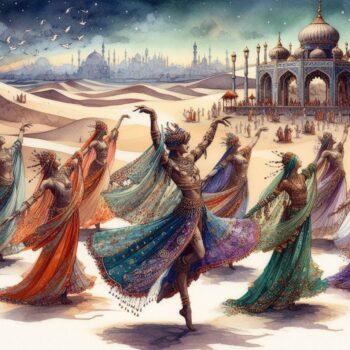
“The veil of class. Is it essential, the struggle between the classes providing the dynamic that powers us forward, if forward we go? Or is it a phase, the step to a more just arrangement? Whatever the answer, the veil of class seems synonymous with the writing of history itself.”
[Narrator exits stage. Light comes on dancers who perform “class” number.]
– APPLAUSE –
[Dancers for “culture” dance take their positions in the wings. Narrator walks on stage.]
“The fourth veil: the veil of culture. With each veil the number of divisions increases. From the veils of gender, race and class to now, the veil of culture, as the surface becomes increasingly coated, opaque, harder to see beyond. So thoroughly trained in the manners and tastes of our own culture, we lose perspective. The other becomes odd, perhaps primitive, as the veil descends. We become hypnotized. Culture-bound.”
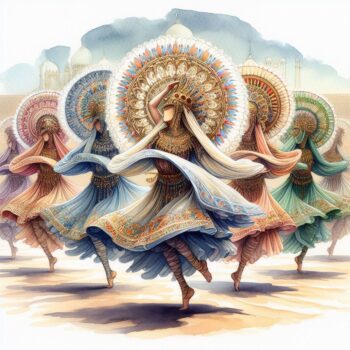
“And yet, it is this veil, the veil of culture, which invites the refinement of the heart and mind. Its requirement: Acquaint yourself with the highest and wisest that has been said and done. Surely it is by this route that we are led past surface understanding, past also our sense of mistaken identity, to an experience of our true and common nature.”
[Narrator exits stage. Light comes on dancers who perform “culture” dance.
(Salome enters stage with veils and leads “culture” number to its conclusion.)]
– APPLAUSE –
[Dancers take their position for “age” number. Narrator walks on stage into light.]
“The fifth veil, the veil of age. Who among us is not baffled by the mystery of Time? And age… what is it anyway, this pilgrimage we are on from infancy to childhood, childhood to old age? And where has this childhood we once knew gone? And old age, from whence cometh it? And why so swiftly? And to thee!”
“It is a dream and yet, at the center there is the same dance throughout all our years. ‘I am the same as I have ever been,’ comes the cry, ‘only the container has weakened. The arc of my existence sends me shooting through, my world line intersecting yours; increasingly, however, I must be on my way. Forget me not lest I wonder if I was here at all.'”

“Time, in one direction it moves, veiling with age and complexity all those who travel through. With every hour, it calls: ‘For this you came. Fill your days. Delight in your projects. Look deeply and with the imagination to that which now and perhaps forever resides in you.'”
[Narrator exits stage. Light comes on dancers who perform “age” dance.
(Spot on Salome at end of dance as she spins with veils.)]
– APPLAUSE –
[Dancers take their positions for “belief” dance. Narrator walks into light.]
“The sixth veil, the veil of belief: ‘Behold the believer but beware the fanatic.’ Belief: the presumption of the truth without having proven that it is so. With this veil we flirt with the closing of the mind. Belief with openness is delicate, an art. Belief with absolute certainty… that is an illusion. The world is too complex, our predicament too uncertain for anyone to know for sure. And yet, time and again, society closes down as the fanatic screams: ‘No! It is my belief, my system, my school that provides the measure. Ye shall be judged by my truth for I have arrived while you remain lost. I have found our home, our destination.’ You—all of us to the fanatic, we remain pilgrims still.”
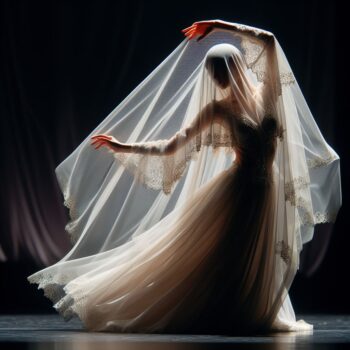
[Narrator exits stage. Light comes on dancers who perform “belief” dance.]
– APPLAUSE –
[Dancers take their position for “behavior” number. Narrator walks on stage and into light.]
“We come, at last, to the seventh veil: the veil of behavior. ‘Conduct is the final thing,’ says the philosopher. It animates the surface, giving expression to the requirements of the previous veils. Through our behavior we announce our gifts, our strengths and, of course, our fears. With it we intensify or lessen our sense of separation, our mistaken identity.”
“Conduct is the final thing. It speaks for itself. Through our behavior we take ourselves more deeply into illusion, the veils taken for ‘the all of reality’, or we begin to unveil ourselves, choosing, creating a world without illusion, with less separation, glimpsing a reality already wondrous, and now, made more inclusive and wise.”
[Narrator exits stage. Light comes on dancers who perform “behavior” number.
– APPLAUSE –
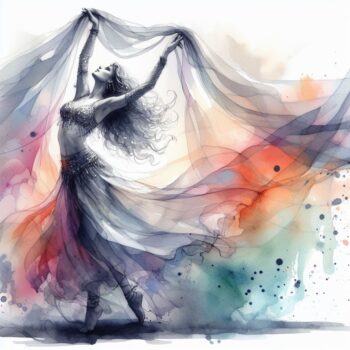
[Dancers take position for final “veils” number. Narrator walks on stage and into light.]
“So ends our performance, our version of this ancient Dance of the Seven Veils. We meant for it to entertain you. Most of all, we wanted that. But we also hope it gave you the experience of your own imagination at work, an experience wherein you practiced the art of separating essence from appearance… as it is to the practice of this fine and rare and much needed art—on the part of us all—that our performance is dedicated.”
[Narrator exits stage. Light comes on dancers who perform final “veils” number.]
– APPLAUSE –
[Dancers run on stage for series of bows. Curtain descends.]
Note to the Reader
The Dance of the Seven Veils was performed by the Mary Waugh Taylor Dance Company in Omaha, Nebraska in 1994 (May 27 & 28) and later, as 7 Veiled Illusions – The Return at the 4th Mid North Coast Belly Dance Festival in Taree, Australia (my thanks to Dekyong Sun). The images throughout the text are not from either of these performances but were generated using Microsoft/Co-Pilot/Create.
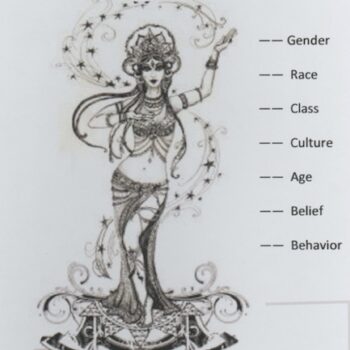
Addendum
The above script was written in 1994. I am aware of the discussions in recent years concerning gender, race, and identity. To accommodate those concerns, portions of the script would need to be revised. However, my view is that the underlying point of the script would not change, i.e., regardless of gender or race identity, the task remains the same: to acknowledge, respect, honor the “veil” in question but to look past it to the humanity held in common.
David Thomas, PhD
